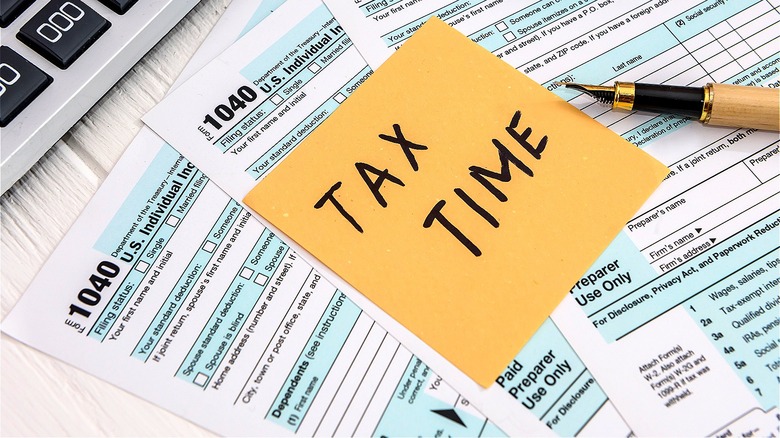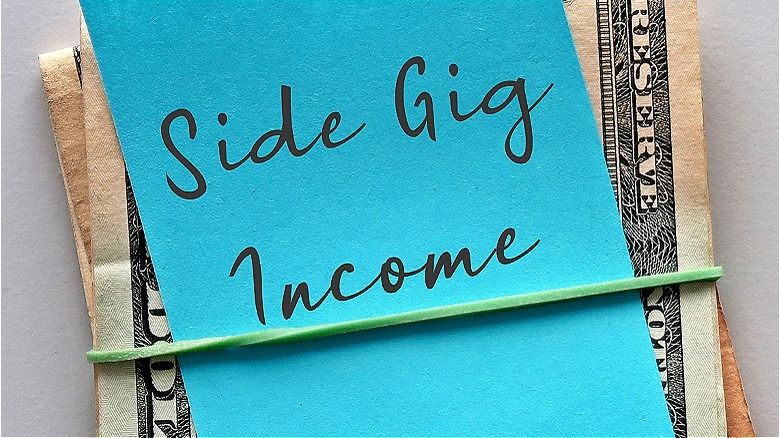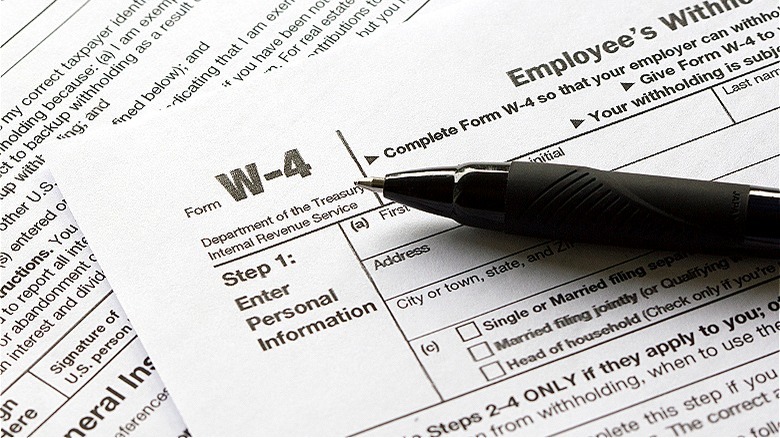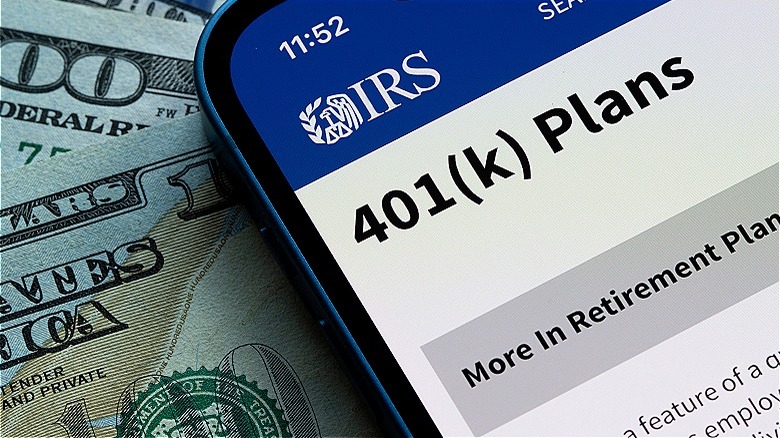2023 Federal Income Tax: 5 Reasons You'll Get A Bill Instead Of A Refund
As you prepare to file your 2023 federal income tax return — due April 15 at latest in most states — you might be envisioning a fat refund check that can be applied toward a relaxing vacation, added to a savings account, or wisely used to pay down any accumulated holiday debt. However, as you're progressing through your favorite tax software, it's quickly becoming apparent you'll actually owe Uncle Sam some money instead of getting a refund.
How can that be? After all, your employer has been deducting taxes from your paycheck all year long. Or in the case of self-employment, you've been diligently making estimated payments each quarter. If you owe the IRS additional funds when filing your return, the reason is simple: You didn't pay enough taxes over the course of the prior year relative to your income. And so, while that part is straightforward, identifying the exact reason why or how that underpayment happened can be more complicated to figure out, but no worries. Money Digest will outline some common causes so you don't make the same mistake next year.
1. You owe on self-employment income
Whether you're self-employed on a full-time basis or you just have a side hustle like driving for Instacart, the IRS considers you an independent contractor and you're going to owe income tax on your earnings. That's true regardless of whether those earnings are extracurricular or your primary source of income. Since independent contractors are typically paid 100% of their gross earnings by a client — that client being Instacart or DoorDash, for example — it's up to you to estimate and pay taxes on self-employment income throughout the year.
Specifically, the IRS requires independent contractors owing $1,000 or more in taxes annually to make quarterly estimated tax payments throughout the year. For 2024, the due dates are January 16, April 15, June 17, and September 16. To calculate your specific estimated payments, consult IRS Form 1040-ES.
Additionally, the overall taxes due may seem higher for freelancers than for employees who are formally employed by a company, sometimes called W-2 employees after the tax form W-2. That's because independent contractors must pay the entire 15.3% self-employment tax that goes toward Medicare and Social Security. In a W-2 position, employers pay about half of these expenses.
If you're self-employed in any capacity and fail to make any quarterly estimated tax payments or significantly underestimated the amount of taxes due, you'll not only be facing a big tax bill when it comes time to file your income tax return, but the IRS can levy fees and interest on the underpaid amount.
2. Your employer isn't withholding enough
In contrast to independent contractors, formal employees of a company have their income tax and other withholdings automatically deducted from their paychecks, which eliminates the need to make complicated estimated payments. However, there's still the potential to owe money come April 15. One common reason is if the information your employer is using to calculate withholdings is no longer accurate.
When beginning a new job, you may recall completing a W-4 form, which provides information to your employer about how much taxes to deduct from paychecks. The information collected on a W-4 includes your marital status, whether you have children or other dependents, and if you're working any additional jobs or have other income, such as from investments.
If the information on your tax return doesn't match what your employer has been using to deduct taxes from your paycheck, you could wind up owing extra money. This could be because the W-4 form wasn't accurately completed to begin with or perhaps some facets of your life have changed since the form was originally completed. It's a good idea to periodically check that the information on your W-4 is still accurate, especially if large-scale changes have occurred in your income and/or family size. Besides owing money, there's also the risk your employer is withholding too much in taxes. Sure, you'll eventually get a tax refund, but your regular paycheck will be smaller than it should be.
3. You owe capital gains tax on investments
If you sold an asset or investment at a profit during the prior year, then congratulations are in order, but also know that Uncle Sam is going to want to share in your windfall. You'll be required to report the transaction on your tax returns and the resultant obligation is known as capital gains tax. Capital gains tax can apply to just about anything that could be considered an asset or investment, including real estate, cryptocurrency, individual stocks, and mutual funds. Though in some circumstances, the profit from the sale of your primary residence is exempt up to a certain dollar amount.
How much tax you pay largely depends on how long you owned the asset prior to selling it. Assets held for one year or less are taxed at the same rate as regular income (between 10% and 37%), but assets held for more than one year are taxed at long-term rates, which are lower. Depending on your other income and filing status, you could pay 0%, 15%, or 20% in long-term capital gains tax. Note that buying and selling carried out in retirement accounts isn't subject to capital gains tax, provided that the earnings remain in the account.
4. You received a bump in pay
Getting a raise is great news, but do be aware that the reward for your hard work could also bump you into a higher income tax bracket. According to TurboTax, "Tax brackets show you the tax rate you will pay on each portion of your taxable income. For example, if you are single, the lowest tax rate of 10% is applied to the first $11,000 of your taxable income in 2023. The next chunk of your income is then taxed at 12%, and so on, up to the top of your taxable income."
The highest tax bracket that's dictated by your income is called the marginal tax rate, while the overall tax rate paid, called the effective rate, will be somewhat lower. That's because the effective rate is based on the progressive tiered approach described above. You can view the latest income-based tax brackets for 2023 on the IRS website.
If your income increases partway throughout the year and you (or your employer) hasn't adjusted your tax withholdings accordingly, you may find that you've underpaid taxes for the year by basing withholdings on your prior lower salary. Finally, if your income jumps above a certain threshold, you could lose access to the earned income tax credit of $600 to $7,430, assuming that you previously qualified.
5. You made a withdrawal from a retirement account
It's almost always a bad idea to make an early withdrawal from tax-deferred retirement accounts like an IRA or 401(k). Sure, your retirement account can be a tempting source of emergency cash in lieu of high interest-rate credit card advances or payday loans, but raiding your retirement account has its own set of pricey pitfalls. Besides the fact that the withdrawn funds are treated like income and taxed accordingly, there's an extra 10% penalty for making any withdrawal before reaching an age of 59 ½ years old.
There are a few exceptions that allow for penalty-free withdrawal, such as the expense of having or adopting children, buying your first home, or paying medical bills. However, penalty-free just means you won't pay the 10% fee for early withdrawal. You'll still pay income tax on the withdrawn funds, not to mention hurting your retirement goals.
A better plan is to start building up an emergency fund with three to six months' worth of living expenses, stored in a high-yield savings account, which can actually make you money. Nonetheless, if accessing funds in a retirement account was a necessity for you in 2023, then expect to write a check to Uncle Sam for the tax consequences.





